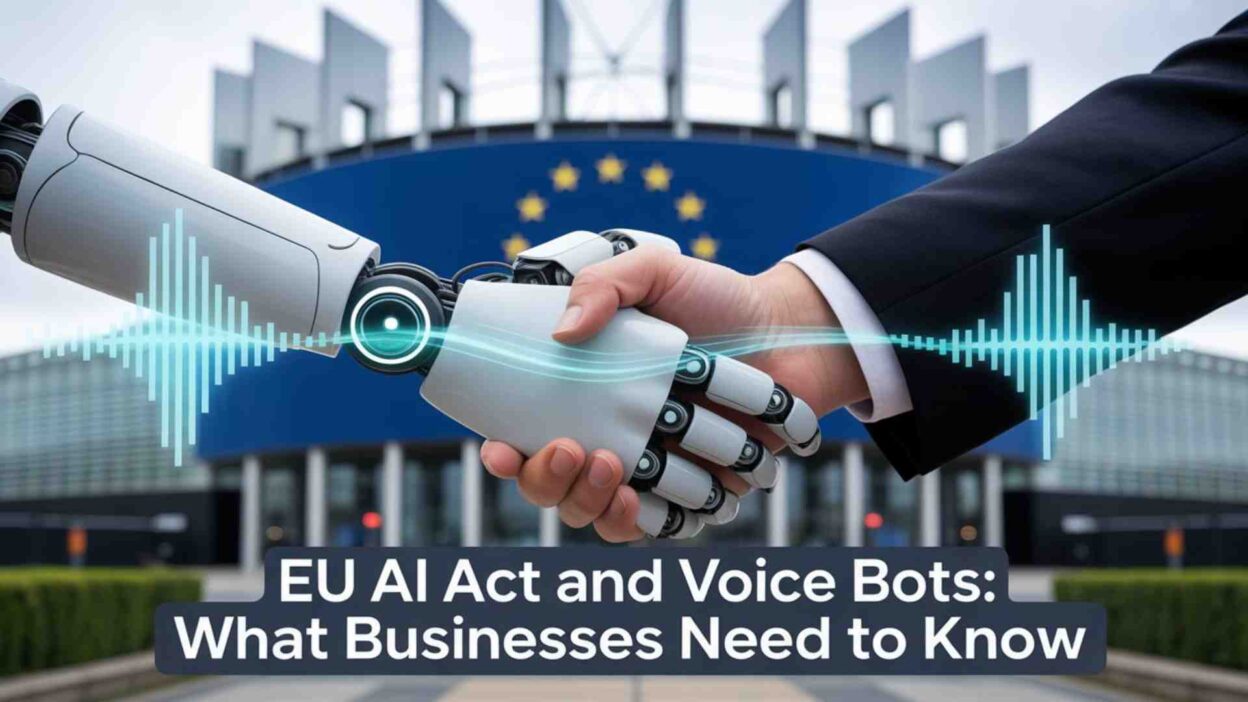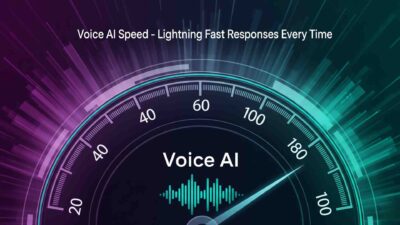TL;DR EU AI Act voice bots regulations are reshaping how businesses deploy automated voice systems across Europe. Companies using voice automation face new compliance requirements that could make or break their European operations.
Table of Contents
What Nobody Tells You About EU AI Act Voice Bot Compliance
You’ve probably seen those promising articles about “simple AI compliance” and “easy voice bot deployment.” Here’s what they don’t tell you about the regulatory nightmare waiting in European markets.
After months of analyzing the EU AI Act and consulting with compliance experts, I’m sharing the unfiltered truth about European voice automation compliance. This isn’t another generic guide filled with legal jargon. This is the reality check you need before your voice bot faces EU regulatory penalties.
The EU AI Act isn’t just another privacy law. It’s a comprehensive framework that fundamentally changes how AI systems operate in Europe. Voice bots fall squarely within its scope. Every automated voice interaction now requires careful legal consideration.
Understanding the EU AI Act Framework for Voice Systems
The EU AI Act creates a risk-based approach to AI regulation. Voice bots are classified based on their potential impact on users. Higher-risk applications face stricter compliance requirements.
Risk Categories That Affect Voice Bots
Minimal Risk Voice Applications: Simple customer service bots typically fall into this category. These systems answer basic questions and route calls. Compliance requirements are relatively light for minimal risk applications.
Basic promotional voice calls also qualify as minimal risk. These automated systems deliver pre-recorded marketing messages. They must still follow existing telemarketing regulations.
Limited Risk Voice Systems: Most business voice bots fall into the limited risk category. These systems interact directly with users in meaningful ways. They require transparency obligations and user notification requirements.
Customer support bots that make decisions qualify as limited risk. Sales automation systems also fall into this classification. European voice automation compliance becomes more complex at this level.
High-Risk Voice Bot Applications: Voice bots used in critical infrastructure are classified as high-risk. Healthcare voice systems that provide medical advice also qualify. Financial services voice bots handling sensitive transactions face high-risk requirements.
Risky EU AI Act voice bots: need extensive documentation and testing. They require conformity assessments before deployment. Ongoing monitoring and reporting obligations apply throughout their lifecycle.
Prohibited AI Practices Affecting Voice Systems
The EU AI Act bans certain voice bot applications entirely. Systems using subliminal techniques to manipulate users are prohibited. Voice bots cannot exploit vulnerabilities of specific groups.
Social scoring systems using voice analysis are banned. Predictive policing voice systems face restrictions. Real-time emotion recognition in voice calls has limited applications.
Technical Requirements for EU AI Act Voice Bots
Data Governance and Training Requirements
Voice bot training data must meet strict quality standards. EU AI Act voice bots require comprehensive data documentation. Training datasets need bias testing and validation procedures.
Data sources must be clearly identified and documented. Personal data used for voice bot training needs explicit consent. Organizations must demonstrate data quality throughout the development process.
Version control systems are mandatory for high-risk voice applications. Every model update requires documentation and testing. Training data lineage must be traceable for audit purposes.
Transparency and Explainability Standards
Users must know when they’re interacting with AI voice systems. Clear disclosure requirements apply to all automated voice interactions. European voice automation compliance demands obvious AI identification.
Voice bots must explain their decision-making processes when requested. Users have the right to understand how automated decisions affect them. Complex explanations must be provided in understandable language.
Documentation must describe voice bot capabilities and limitations. Known biases and potential errors require disclosure. System accuracy rates need public reporting for high-risk applications.
Human Oversight Requirements
High-risk voice bots need meaningful human supervision. Human operators must be able to override AI decisions. Emergency stop mechanisms are required for critical systems.
Staff operating voice bots need appropriate training and qualifications. Regular competency assessments ensure proper system oversight. Decision-making authority must remain with qualified humans.
Quality management systems must include human review processes. Regular audits verify that human oversight is effective. Documentation must prove human control over critical decisions.
Industry-Specific Compliance Requirements
Healthcare Voice Bots Under EU AI Act
Medical voice bots face the strictest EU AI Act requirements. These systems are automatically classified as high-risk applications. Conformity assessments are mandatory before market deployment.
Clinical evidence requirements apply to diagnostic voice systems. Safety studies must demonstrate medical effectiveness. Post-market surveillance monitors real-world performance continuously.
Medical device regulations may also apply to healthcare voice bots. CE marking requirements could affect deployment timelines. Notified body involvement may be necessary for complex systems.
Financial Services Voice Automation
Banking voice bots handling customer verification are high-risk systems. Credit decision voice bots also face strict compliance requirements. European voice automation compliance in finance involves multiple regulatory frameworks.
Anti-money laundering requirements affect voice bot operations. Customer due diligence procedures must include AI system oversight. Record-keeping requirements extend to voice bot interactions.
Consumer protection laws add another compliance layer. Voice bots must provide clear pricing information. Complaint handling procedures must accommodate AI-related issues.
Customer Service and Sales Voice Bots
Most customer service voice bots qualify as limited risk systems. Transparency requirements are the primary compliance obligation. Clear AI disclosure must occur at interaction start.
Sales voice bots face consumer protection requirements. Misleading AI interactions can trigger regulatory penalties. Cooling-off periods must be clearly communicated by voice systems.
EU AI Act voice bots in sales cannot use deceptive practices. Pressure selling techniques are heavily restricted. Age verification may be required for certain product categories.
Implementation Timeline and Penalties
Phased Implementation Schedule
The EU AI Act implementation occurs in phases over several years. Prohibited AI practices became illegal immediately upon law adoption. High-risk system requirements phase in over 24 months.
Limited risk transparency obligations have shorter implementation timelines. Organizations have 12 months to implement disclosure requirements. European voice automation compliance deadlines vary by risk category.
Existing voice bot systems need compliance updates during implementation periods. Grandfathering provisions are limited and specific. Most systems require some level of modification for compliance.
Penalty Structure for Voice Bot Violations
EU AI Act penalties are severe and business-threatening. Fines can reach 7% of annual global turnover. Prohibited AI practice violations carry the highest penalties.
Administrative fines start at €15 million for serious violations. Repeat offenders face enhanced penalty structures. Market access can be blocked for non-compliant systems.
National enforcement authorities have broad investigation powers. They can require system modifications or complete shutdowns. Compliance costs multiply quickly after violations occur.
Building EU AI Act Compliant Voice Bot Systems
Risk Assessment and Classification
Conduct thorough risk assessments for all voice bot applications. EU AI Act voice bots require careful legal classification. Professional legal advice is essential for complex systems.
Document risk assessment procedures and outcomes comprehensively. Regular reviews ensure classifications remain accurate over time. System modifications may change risk categories and requirements.
Create risk matrices for different voice bot use cases. Some applications clearly qualify as high-risk systems. Others may have ambiguous classifications requiring expert analysis.
Documentation and Record-Keeping Requirements
Maintain comprehensive technical documentation for all voice systems. EU AI Act voice bots need detailed system descriptions. Architecture diagrams and data flow charts are mandatory.
Keep detailed records of all training data and model versions. Change logs must document every system modification. European voice automation compliance requires extensive paperwork.
Quality management documentation must be continuously updated. Incident reports and corrective actions need proper documentation. Audit trails must be available for regulatory inspection.
Testing and Validation Procedures
Implement rigorous testing protocols for voice bot accuracy. Bias testing is mandatory for high-risk applications. Performance monitoring must continue throughout system lifecycle.
Create test scenarios covering edge cases and failure modes. Voice bots must handle unexpected inputs gracefully. Error handling procedures need comprehensive documentation.
Regular penetration testing ensures system security. Vulnerability assessments identify potential compliance risks. Third-party testing may be required for high-risk systems.
Practical Steps for Voice Bot Compliance
Immediate Action Items
Review all existing voice bot deployments for EU AI Act compliance. Identify systems that may require immediate modifications. Create compliance timelines for each voice application.
Implement clear AI disclosure mechanisms in all voice interactions. Users must know they’re speaking with automated systems. European voice automation compliance starts with transparency.
Establish human oversight procedures for automated voice decisions. Train staff on EU AI Act requirements and responsibilities. Create escalation procedures for complex situations.
Medium-Term Compliance Strategies
Develop comprehensive quality management systems for voice bots. Document all procedures and training materials thoroughly. Regular audits ensure ongoing compliance with changing requirements.
Create incident response procedures for compliance violations. Quick response to regulatory issues minimizes potential penalties. Establish contacts with local legal counsel in EU jurisdictions.
Implement automated compliance monitoring where possible. Real-time alerts can catch violations before they escalate. Regular compliance reporting helps identify trends and improvement opportunities.
Long-Term Strategic Planning
Plan for ongoing regulatory changes and updates. The EU AI Act will evolve through implementing regulations. Voice bot compliance requirements will become more detailed over time.
Consider certification programs for voice bot systems. Third-party certification may become market requirements. Early adoption provides competitive advantages in regulated markets.
Build compliance expertise within your organization. Internal capabilities reduce dependence on external consultants. Staff training ensures consistent application of compliance procedures.
Technology Solutions for EU Compliance
Voice Bot Platform Selection
Choose platforms designed for EU AI Act compliance. Built-in compliance features reduce implementation complexity. Vendor compliance expertise prevents costly mistakes.
Evaluate platforms based on documentation and audit capabilities. Comprehensive logging is essential for regulatory reporting. European voice automation compliance requires detailed system monitoring.
Consider platforms with automatic compliance checking features. Real-time monitoring identifies potential violations immediately. Automated alerts prevent minor issues from becoming major problems.
Data Management and Privacy Integration
Implement data governance systems that support voice bot compliance. EU AI Act voice bots need comprehensive data tracking. GDPR integration is essential for European operations.
Create data retention policies that satisfy multiple regulatory frameworks. Voice data has specific handling requirements under various laws. Automated deletion prevents compliance violations.
Establish data quality monitoring for voice bot training sets. Poor data quality can lead to biased or inaccurate systems. Regular audits identify and correct data problems.
Monitoring and Reporting Tools
Deploy comprehensive monitoring systems for voice bot performance. Real-time dashboards show compliance status across all systems. Historical reporting supports regulatory submissions.
Create automated reporting for required compliance metrics. Regular reports to management ensure ongoing attention to compliance issues. Stakeholder updates demonstrate commitment to regulatory adherence.
Implement user feedback systems for voice bot interactions. Customer complaints can identify compliance problems early. Feedback analysis helps improve system performance and user satisfaction.
Hidden Costs of EU AI Act Compliance
Initial Implementation Expenses
Legal consultation costs can reach tens of thousands of euros. Complex voice bot systems require extensive legal review. EU AI Act voice bots need specialized compliance expertise.
Technical modifications for compliance are often expensive. Legacy systems may require complete rebuilding. Emergency fixes cost significantly more than planned implementations.
Staff training and certification add substantial costs. Compliance personnel need ongoing education and updates. European voice automation compliance requires specialized knowledge.
Ongoing Operational Costs
Regular audits and compliance monitoring create recurring expenses. Third-party assessments may be required annually. Documentation maintenance requires dedicated resources.
Regulatory reporting obligations need staff time and systems. Compliance officers must track multiple regulatory requirements. Ongoing legal counsel becomes a business necessity.
System modifications for regulatory updates are inevitable. The EU AI Act will evolve through implementing regulations. Voice bot systems need regular compliance updates.
Risk Mitigation and Insurance
Compliance insurance premiums reflect regulatory risk levels. High-risk voice bot applications face higher insurance costs. Coverage gaps can leave organizations exposed to penalties.
Legal reserves may be necessary for potential regulatory issues. Compliance violations can trigger lengthy legal proceedings. Settlement costs can reach millions of euros.
Reputational damage from compliance failures affects business value. Customer trust takes years to rebuild after violations. Market access restrictions can permanently damage growth prospects.
Best Practices from Early Adopters
Successful Compliance Strategies
Start compliance planning early in voice bot development. EU AI Act voice bots benefit from compliance-by-design approaches. Retrofitting compliance is always more expensive and less effective.
Create cross-functional compliance teams with diverse expertise. Legal, technical, and business stakeholders must collaborate closely. European voice automation compliance requires coordinated efforts.
Document everything thoroughly from project inception. Comprehensive records support regulatory submissions and audits. Good documentation practices prevent compliance gaps.
Common Implementation Mistakes
Underestimating documentation requirements is a frequent error. EU AI Act voice bots need extensive written procedures. Inadequate documentation leads to compliance failures.
Ignoring ongoing monitoring obligations creates compliance risks. One-time compliance assessments are insufficient for complex systems. Continuous monitoring prevents regulatory violations.
Failing to plan for regulatory updates causes compliance gaps. The EU AI Act implementation will clarify many requirements. Voice bot systems need flexibility for regulatory changes.
Lessons Learned from Compliance Failures
Inadequate risk assessment leads to inappropriate compliance measures. Systems classified incorrectly face regulatory scrutiny. Professional risk assessment prevents classification errors.
Poor human oversight implementation creates liability exposure. Token human involvement doesn’t satisfy regulatory requirements. Meaningful human control must be demonstrable and effective.
Insufficient staff training causes operational compliance failures. Technical staff must understand regulatory requirements thoroughly. Regular training updates ensure consistent compliance application.
Future Outlook for Voice Bot Regulation
Upcoming Regulatory Developments
Implementing regulations will clarify many EU AI Act requirements. Technical standards for voice bots are under development. Harmonized approaches will simplify compliance across EU member states.
National implementation may create additional requirements. Some countries are developing supplementary voice bot regulations. European voice automation compliance may become more complex over time.
International coordination on AI regulation is increasing. Similar laws in other jurisdictions may align with EU approaches. Global compliance standards could emerge from regulatory coordination.
Technology Evolution and Compliance
Voice bot capabilities continue advancing rapidly. New features may change regulatory risk classifications. Compliance strategies must adapt to technological developments.
Real-time compliance monitoring tools are improving quickly. Automated compliance checking will become more sophisticated. EU AI Act voice bots will benefit from better compliance technology.
Industry standards for voice bot compliance are emerging. Professional certification programs may become market requirements. Early adoption of standards provides competitive advantages.
Market Implications
Compliance costs will favor larger organizations with dedicated resources. Small businesses may struggle with EU AI Act requirements. Market consolidation could result from compliance barriers.
Compliant voice bot systems may command premium pricing. Certified systems provide reduced regulatory risk for buyers. European voice automation compliance becomes a competitive differentiator.
Innovation in compliance technology will create new market opportunities. Compliance-as-a-service offerings are already emerging. Specialized compliance vendors will serve the voice bot market.
Building a Compliance-Ready Organization
Organizational Structure for Compliance
Establish clear accountability for voice bot compliance within your organization. Senior leadership must own compliance outcomes and resource allocation. EU AI Act voice bots require executive-level attention.
Create compliance officer roles with appropriate authority and resources. These positions need direct access to senior management. Compliance officers must have technical and legal expertise.
Develop compliance committees that include all relevant stakeholders. Regular meetings ensure ongoing attention to regulatory requirements. Cross-functional coordination prevents compliance gaps.
Staff Training and Development
Implement comprehensive training programs for all staff involved with voice bots. Technical teams need compliance awareness and specific skill development. European voice automation compliance affects multiple job functions.
Create role-specific training materials for different organizational functions. Developers need technical compliance requirements. Sales teams need market positioning and customer communication guidance.
Establish ongoing education programs for regulatory updates. The EU AI Act implementation will create new requirements over time. Staff knowledge must stay current with regulatory developments.
Culture and Mindset Changes
Foster a compliance-first culture throughout your organization. Compliance cannot be an afterthought in voice bot development. EU AI Act voice bots require embedded compliance thinking.
Reward compliance excellence and proactive risk identification. Staff incentives should align with regulatory adherence. Compliance achievements deserve recognition and career advancement opportunities.
Create psychological safety for reporting compliance concerns. Staff must feel comfortable raising potential issues. Early identification of problems prevents regulatory violations.
Read More: Automating Sales With AI Technology
Conclusion

The EU AI Act represents a fundamental shift in how businesses must approach voice bot development and deployment. EU AI Act voice bots face unprecedented regulatory scrutiny that demands proactive compliance planning and ongoing vigilance. Organizations that ignore these requirements face severe penalties and potential market exclusion.
European voice automation compliance is not just about avoiding fines. It’s about building sustainable competitive advantages in the world’s most sophisticated regulatory environment. Companies that master EU AI Act compliance will be positioned to succeed in other international markets as similar regulations emerge globally.
The businesses that invest in robust compliance systems today will dominate tomorrow’s voice automation markets. Those who treat compliance as an afterthought will face regulatory penalties, market restrictions, and competitive disadvantage. The choice is clear: embrace EU AI Act compliance as a strategic opportunity, or risk losing access to Europe’s lucrative voice bot markets forever.





